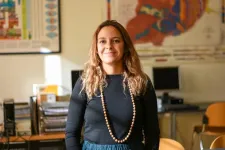(Press-News.org)
Half of all marriages in the United States are likely to fail by the time the spouses reach their 50s. Understandably, many couples are looking for ways to avoid becoming part of that statistic, well aware of a divorce’s possible wide-reaching detrimental effects on families, children, personal finances, individual well-being—and direct and indirect costs to society.
Ronald Rogge, an associate professor of psychology at the University of Rochester, has been researching the complex dynamics of romantic relationships and families for nearly three decades, searching for ways to help couples nurture and strengthen their love.
One of those ways—his newest and “most successful project, based on its extensive reach,” Rogge says—is a relationship app that he codeveloped with a former University of Rochester student, Khadesha Okwudili. In a recent pilot study, published in the Journal of Family Psychology, Rogge found that the overwhelming majority of study participants—8 out of 10—reported improved and healthier relationships after one month of app usage.
“Our primary goal was to create an app that couples would intrinsically enjoy using, which would naturally grow in popularity, and thereby organically extend its reach,” says Rogge.
Barely in her twenties, Okwudili was diagnosed with a life-threatening heart arrhythmia disorder. Several near-death experiences inspired her to ask more meaningful questions of the people she loved, “because I wasn’t sure how much time I would have left with them,” Okwudili recalls. “Over time, I realized that although my health was deteriorating, my relationships started thriving in a way that they hadn’t before.” Together with Rogge, she began to develop and test content for Agapé, generating thousands of questions that would be relevant for a wide range of couples.
How does the Agapé relationship app work?
Agapé sends registered couples a daily prompt, such as “What’s something that your partner did in the past week that made you laugh?” or “Describe a time you were thankful to have your partner by your side” or “If your partner had a theme song that would play around them as they went through their day, what would it be and why?” Or something more outlandish, such as: “What unique skills would your partner bring to surviving a zombie apocalypse?”
Once both partners have answered the prompt, they can see each other’s responses, possibly sparking a meaningful conversation, “enhancing awareness” and promoting “moments of connection,” says Rogge, who has pilot tested over 4,000 prompts over the last four years, grounded in marital and couples research of the last 40 years.
How effective is the app? A scientific test
For the recent pilot study, the researchers recruited 405 romantic couples. Ninety-one percent were heterosexual and the vast majority (84 percent) in their twenties and thirties. The couples had been in their current relationships for an average of 4.6 years. While most couples in the study, 31 percent of whom were married, were reasonably satisfied with their relationships, roughly a third were notably not.
The team followed the participants over the course of one month on the app, during which the couples completed baseline assessments at the start, shorter weekly wellness checks within the app, and again an assessment at the end of the month. Engagement remained high throughout, with 99 percent of couples using the app, and 88 percent providing follow-up data.
Key findings
80 percent of participants reported improved romantic relationships, including a decrease in perceived negative relationship qualities, and an increase in relationship satisfaction and dedication.
70 percent saw improvements in their own well-being, such as reporting higher vitality and a better quality of life, concurrent with a noticeable drop in depressive symptoms.
Couples who completed more daily prompts had stronger gains in relationship quality.
93 percent said the app was enjoyable, and 74 percent said it was easy to use, which the researchers hope will increase the likelihood of regular use.
Over the past half century, a wide range of interventions to make relationships stronger have been developed. Yet research has shown that practical barriers, such as the need for trained facilitators, have resulted in limited dissemination. Other self-directed interventions, while cheap and practical, were often hampered in their reach and effectiveness by low levels of engegement, with couples completing only a small fraction of the requirements.
Rogge is excited about the app project because “it helps get my research into the hands of millions of couples and, I hope, will actually improve their lives.”
Although the present study focuses on romantic relationships, the app can also be used to help you feel close to friends or family. According to the team, the fundamental principles that underpin couples’ ties generalize to other kinds of close relationships. “Using the app with more people in your life is likely to have even stronger individual benefits because we know that connecting with others is a fundamental psychological need," Rogge says.
Because Rogge and Okwudili are both stockholders in Agapé Wellness Inc., the study was conducted under a conflict-of-interest plan with the University of Rochester. The study’s data and materials can be accessed at the Open Science Framework.
END
Catarina Frazão Santos, researcher at the Faculty of Sciences of the University of Lisbon (Portugal) (Ciências ULisboa), has been awarded by the European Research Council (ERC) with a Starting Grant of approximately 1.5 million euros to study the benefits and challenges of developing sustainable, equitable and climate-smart marine spatial planning processes in Antarctica and beyond.
“We need to raise awareness and foster a ‘paradigm shift’ on how to plan for sustainability and equity in a changing ocean,” says Catarina ...
Researchers from the Smithsonian’s National Museum of Natural History led a new analysis that sheds light on the ancestry and genetics of woolly dogs, a now extinct breed of dog that was a fixture of Indigenous Coast Salish communities in the Pacific Northwest for millennia. Anthropologist Logan Kistler and evolutionary molecular biologist Audrey Lin analyzed genetic clues preserved in the pelt of “Mutton,” the only known woolly dog fleece in the world, to pinpoint the genes responsible for their ...
UNDER EMBARGO UNTIL 19:00 GMT / 14:00 ET THURSDAY 14 DECEMBER 2023
Diverse gut bacteria communities protect against harmful pathogens by nutrient blocking
New study demonstrates that diverse communities of resident bacteria can protect the human gut from disease-causing microorganisms.
However, this protective effect is lost when only single species of gut bacteria are present.
The researchers found that protective communities block the growth of harmful pathogens by consuming nutrients that the pathogen needs.
The findings, published today in the journal Science, could help to develop new strategies to optimise gut health.
The ...
Astronomers at the University of Toronto have discovered a population of massive stars that have been stripped of their hydrogen envelopes by their companions in binary systems. The findings, published today in Science, shed light on the hot helium stars that are believed to be the origins of hydrogen-poor core-collapse supernovae and neutron star mergers.
For over a decade, scientists have theorized that approximately one in three massive stars are stripped of their hydrogen envelope in binary systems. Yet, until now, only one possible candidate had been identified.
“This was such a big, glaring hole,” says co-lead author ...
DNA analysis of a 19th-century dog, paired with traditional knowledge acquired through interviews, have together provided new insights into the decline of Coast Salish “woolly dogs” – an extinct Indigenous dog once bred for its unique woolly coat. Dogs were introduced to the Americas at least 15,000 years ago and have been ubiquitous in Indigenous societies across the continents for thousands of years. Coast Salish peoples – a group of Indigenous societies that lived in the Salish Sea region of the Pacific Northwest (PNW) – kept several different types of dogs, including a special lineage of “woolly ...
Science has named the development of glucagon like peptide-1 (GLP-1) agonists and this year’s discovery that these drugs can blunt obesity-associated health problems as its 2023 Breakthrough of The Year. Although obesity’s causes span genetic, physiological, environmental, and social factors, as a medical problem, obesity’s risks can be life-threatening – including heart disease, diabetes, arthritis, liver disease, and certain cancers. Drug treatments for obesity have had “a sorry past, one often intertwined with social pressure to lose weight and the widespread belief that excess weight reflects weak willpower,” writes ...
Genomic analyses reveal illegal pangolin trafficking routes from origins in Africa to markets in Asia, researchers report. The approach offers new opportunities to monitor pangolin poaching in near real-time, allowing for targeted and more effective anti-trafficking measures. The illegal wildlife trade is a significant driver of global biodiversity loss. Of all the species poached and traded, the white-bellied pangolin (Phataginus tricuspis) is the world’s most trafficked mammal and is at risk of extinction. Pangolins are in high demand in Asia because their scales are believed, without scientific support, ...
Combining a flexible solar cell with an electrocaloric device, researchers have created solar-powered clothing that allows the body to adapt dynamically to changes in ambient temperature, according to a new study. The new device could help guarantee the safety and comfort of the human body amid fluctuating environmental temperatures and even extend survivability in extreme environments, like those in outer space or other planets. Clothing is the most common way humans regulate their body temperature relative to the environment. However, it is normally focused on keeping an individual either warm or cool. The ability of clothing to ...
Supernovae–stellar explosions as bright as an entire galaxy–have fascinated us since time immemorial. Yet, there are more hydrogen-poor supernovae than astrophysicists can explain. Now, a new Assistant Professor at the Institute of Science and Technology Austria (ISTA) has played a pivotal role in identifying the missing precursor star population. The results, now published in Science, go back to a conversation the involved professors had many years ago as junior scientists.
Some stars do not simply die down, but explode in a stellar blast that could outshine ...
The ‘Nature Restoration Law’ (NRL) requires member states of the EU to implement restoration measures on at least 20 per cent of land and marine areas by 2030, and in all ecosystems in need of restoration by 2050. This includes specific targets to rewet peatlands and to increase pollinator populations. The NRL has already overcome various hurdles: most recently, it was approved by the EU Parliament’s Environment Committee, after delegations of the Parliament and the Council negotiated the final text.
But will the regulation really achieve its aims? The authors, including scientists leading large European projects on ...







